With their agile movements and playful antics, squirrels can often be a delightful sight in our backyards. They are incredibly cute and fascinating to watch. However, their charm can quickly fade when they dig up plant bulbs, nibble on plants, and create general havoc in your garden! While numerous methods exist to deter these bushy-tailed creatures, you might be after natural solutions to ensure no one (not even a little squirrel) is hurt in the process. One practical and environmentally friendly method to repel and keep squirrels out of your yard is by using plants as deterrents. Plants can serve as natural repellents due to their scent or taste, which squirrels and other pests, might find unappealing. This article will delve into 10 specific plants you can plant in your garden to keep squirrels out while enhancing the look of your garden. Let’s dive in!
1. Alliums (Allium)
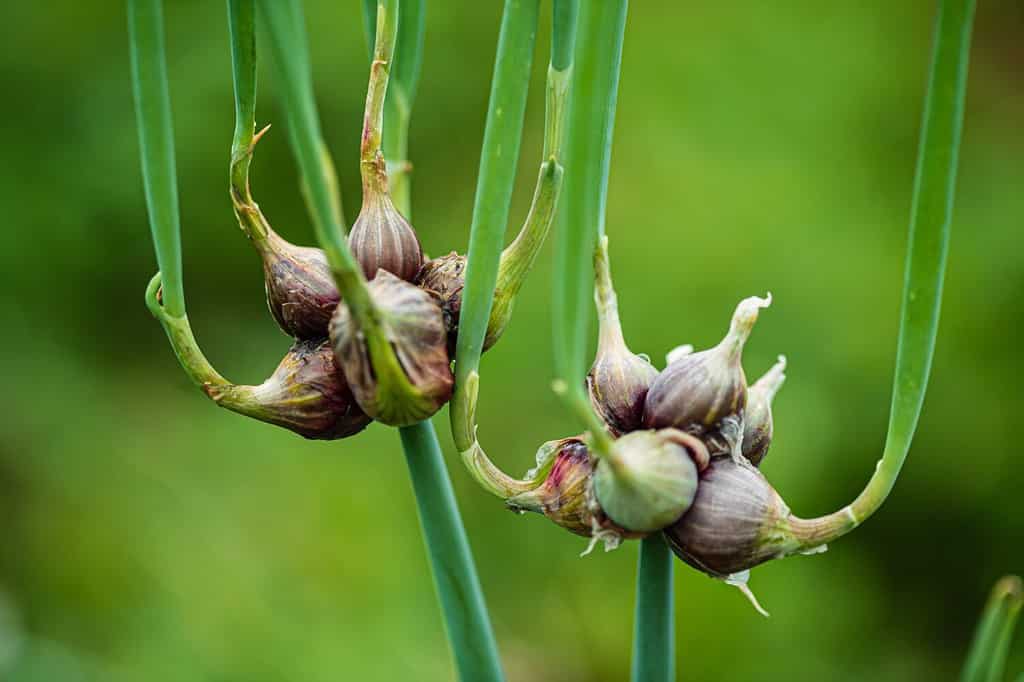
Various alliums, such as garlic and onions, can deter squirrels thanks to their strong and aromatic smells and flavors.
©Shebeko/Shutterstock.com
Allium is a genus of flowering plants that includes garlic, onions, leeks, and many ornamental varieties. These plants can be an effective deterrent against squirrels. Alliums contain natural compounds that give them their characteristic odors and flavors. And while we may like these smells, squirrels find them offensive.
Since the strong scent emanating from alliums is a repellent to many small critters, including squirrels, alliums can be a potent tool in keeping these critters at bay. They work by masking the aroma of more enticing plants or by simply making an area unpleasant and uncomfortable due to the strong smell. Additionally, squirrels are instinctively wary of digging in areas where they can detect the strong smell of alliums, as it can often signal a plant that’s inedible or potentially harmful if consumed.
How to Plant Alliums to Repel and Keep Squirrels Out
Strategic planting is critical when using alliums as a natural squirrel repellent. Plant them throughout the garden, particularly around the base of plants that squirrels find most tempting, for best results. For instance, if you have a bed of bulbs or vegetables that squirrels are fond of, planting alliums around the perimeter can act as a natural barrier.
The placement works in more ways than one. Firstly, the odor dissuades squirrels from approaching. Secondly, if they do happen to venture close, they are less likely to dig and plant their food stashes near these strongly-scented plants. Furthermore, the tall stalks and vibrant blooms of ornamental allium varieties can also add an aesthetic appeal to gardens, making them both functional and visually pleasing: the best of both worlds!
2. Daffodils (Narcissus)

While also beautiful, another reason to plant daffodils in your garden is that its toxic alkaloid compound makes it unpalatable for squirrels.
©Andrew Fletcher/Shutterstock.com
Daffodils are a visual delight and have a lesser-known advantage: they are a natural deterrent for squirrels. A key reason behind this is the presence of lycorine, a bitter and toxic alkaloid found in all parts of the daffodil plant. This compound makes daffodils unpalatable to many pests, including squirrels. When squirrels, known for their habitual digging and penchant for bulbs, encounter daffodils, they are instinctively put off by the taste and toxicity of these bulbs. As a result, unlike tulip bulbs or other squirrel favorites, daffodil bulbs remain largely untouched by these pesky critters. Additionally, even if a curious squirrel were to take a bite, the immediate bitter taste is a strong deterrent. This discourages further nibbling and thus protects the bulbs.
How to Plant Daffodils to Repel and Keep Squirrels Out
Strategically incorporating daffodils into your garden layout can effectively reduce squirrels from entering and disturbing your yard. Planting them as protective borders around more vulnerable plants or bulbs can act as a safeguard. By planting them in this way, squirrels, while foraging, are likely to encounter the daffodil bulbs first. Upon doing so, they will be quickly dissuaded from digging further, effectively protecting the neighboring plants.
Another method is to interplant daffodils with other bulbs, like tulips, creating a mixed planting that confuses and deters squirrels. This way, even if a squirrel decides to dig, the chances of it hitting a daffodil bulb first are higher, safeguarding the other bulbs. And the best part? Perennial daffodils provide a long-term solution. They emerge year after year to enhance the garden’s beauty while serving as an effective squirrel repellent.
3. Hyacinth (Hyacinthus)
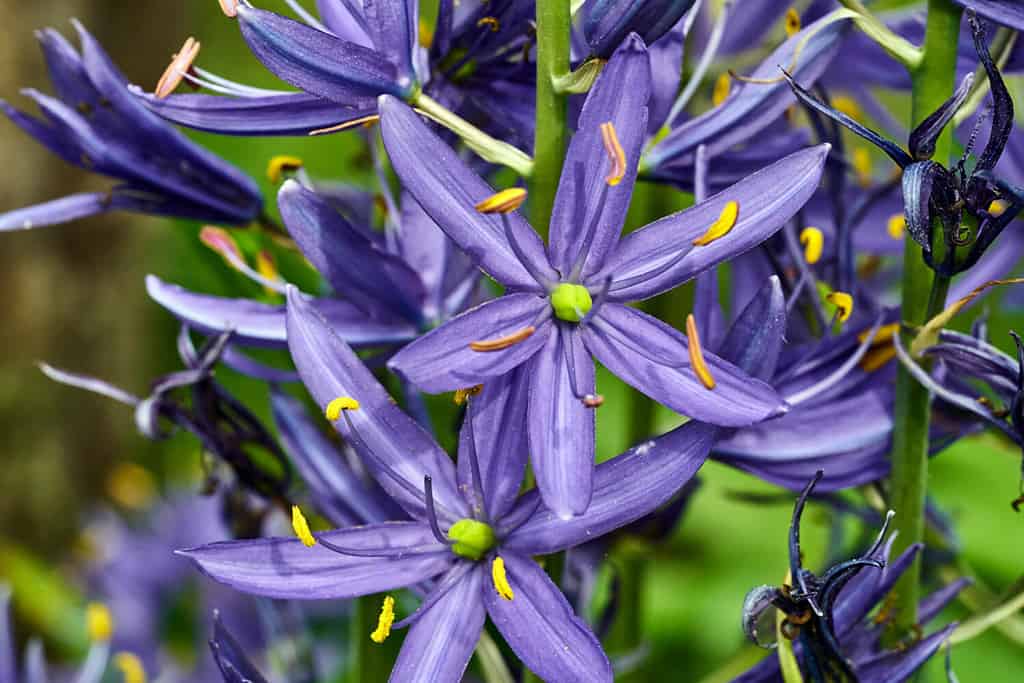
A popular garden flower, hyacinth is a great plant for your garden if you are looking to deter squirrel activity.
©Jonas Vegele/Shutterstock.com
Hyacinths are popular among gardeners to bring in the spring season. Beyond their aesthetic appeal, hyacinths repel squirrels, as the bulbs of the hyacinth plant are hard and dense. These bulbs are thus less appetizing for squirrels than softer, more easily chewable bulbs. Moreover, hyacinths contain certain compounds that are off-putting and even toxic to these fluffy visitors. And if that’s not enough to deter squirrels, although people enjoy the strong smell of hyacinth, for squirrels, this aroma is too much for them to handle.
How to Plant Hyacinth to Repel and Keep Squirrels Out
As always, make sure to plant the hyacinth strategically in order to maximize its properties as a squirrel deterrent. Plant hyacinth bulbs nearby plants that are typically more susceptible to squirrel predation. Doing this creates a patchwork underground that can deter squirrels from digging, fearing they might hit upon the less desirable hyacinth bulbs. Additionally, forming a perimeter or barrier using hyacinths around particularly vulnerable garden areas can be a good idea.
4. Common Snowdrop (Galanthus nivalis)
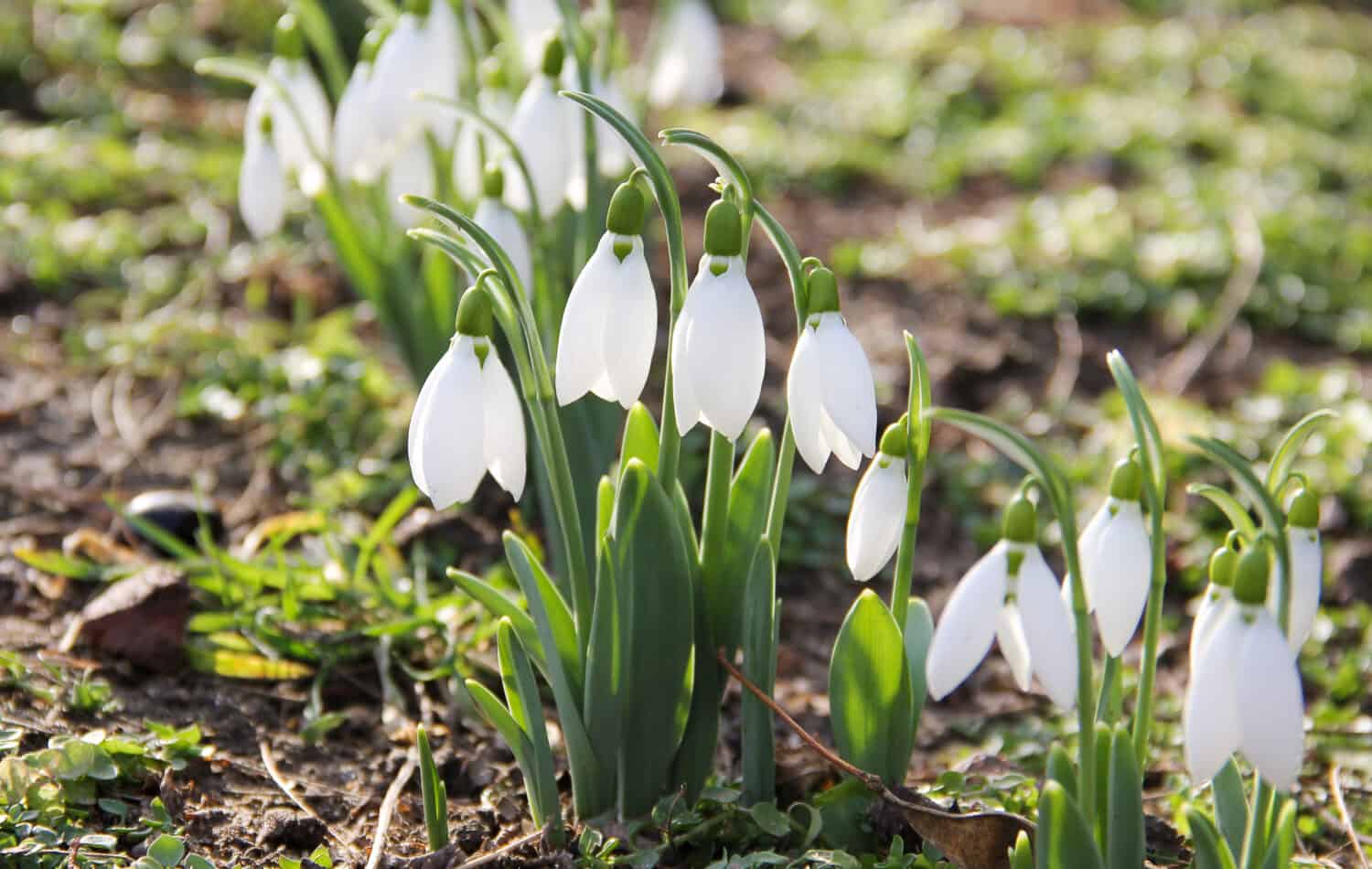
Although beautiful, common snowdrops contain alkaloids that don’t taste very good and can even be toxic.
©Olesya Myzzz/Shutterstock.com
Common snowdrops are among the earliest bloomers in many gardens. They pierce through the last remnants of snow to announce the warming arrival of spring. These delicate white flowers, hanging like droplets from slender stalks, symbolize resilience and can be an effective deterrent against unwanted garden visitors like squirrels.
Common snowdrop bulbs, much like certain other bulbous plants, contain alkaloids that don’t taste very good and can be toxic when consumed in large amounts. With their keen foraging instincts, squirrels have learned to associate these bulbs’ taste and potential ill effects, making them less likely to dig up and consume snowdrops or nearby plants.
How to Plant Common Snowdrop to Repel and Keep Squirrels Out
To maximize the squirrel-repellent features of common snowdrops in your garden, consider planting them in areas frequently visited or disturbed by your squirrel friends. Specifically, plant them in clusters or swathes across squirrel-prone zones, discouraging these critters from digging up more palatable bulbs nearby. Planting snowdrops, among other bulbous plants, can offer those more desirable plants a level of protection.
5. Lily of the Valley (Convallaria majalis)

The ever-so-beautiful lily of the valley is known to be a deterrent to squirrels and other pests.
©Viacheslav Rubel/Shutterstock.com
With its fragrant bell-shaped white flowers and glossy green leaves, lily of the valley is a favorite among many garden enthusiasts for its aesthetic appeal and sweet perfume smell. However, beneath its delicate appearance, this plant boasts a robust defense mechanism against many pests, including squirrels. The entire lily of the valley plant, from its roots to its blooms, contains toxic compounds when ingested. These compounds commonly deter herbivores, including squirrels, from feeding on them.
Squirrels, being opportunistic foragers with a keen sense of which plants to avoid, typically steer clear of the lily of the valley due to its known toxicity and potentially unpleasant taste. This natural aversion ensures that the lily of the valley plants, especially their rhizomes, are left undisturbed by the squirrels, leaving your yard a pristine paradise.
How to Plant Lily of the Valley to Repel and Keep Squirrels Out
For gardeners aiming to harness the squirrel-repellent characteristics of the lily of the valley, the plant’s placement is essential. Like other deterring plants, planting them where squirrels are particularly active can help protect nearby plants from these foraging creatures. Using lilies of the valley as border plants or creating dense patches within squirrel-frequented zones can also be an effective deterrent.
6. Geraniums (Pelargonium)
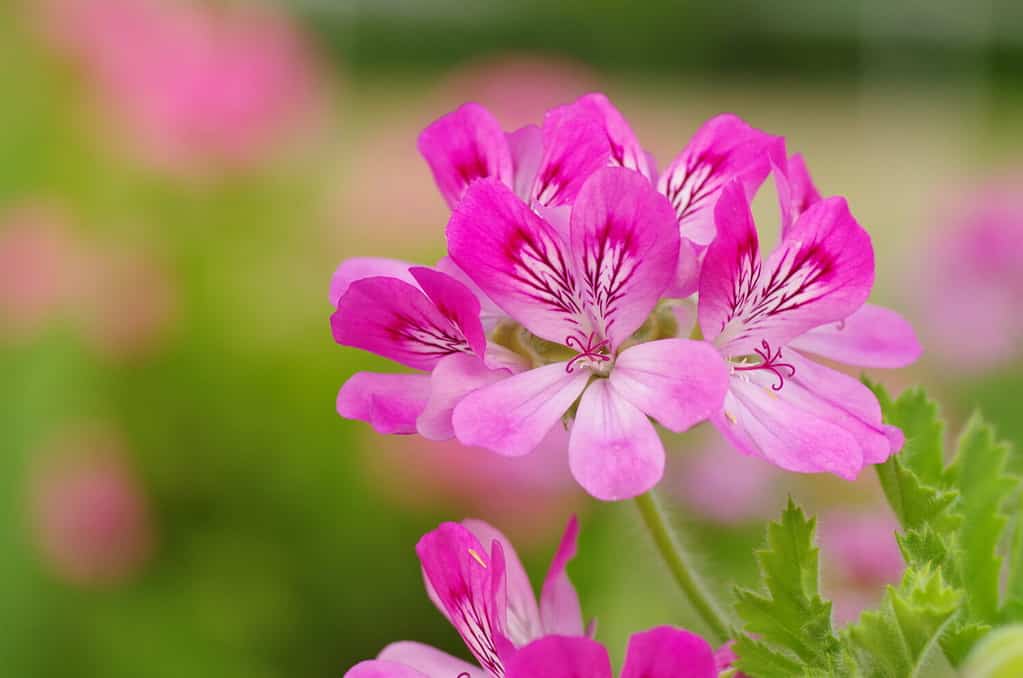
Another beautiful plant you can plant in your garden while also deterring squirrels is geranium.
©mutsu7211/Shutterstock.com
Geraniums, known for their vibrant flowers and deeply lobed leaves, are visually striking additions to gardens and patios and can also serve a pragmatic purpose in deterring certain pests, such as squirrels. The reason behind this deterrence lies in the geranium’s natural chemical makeup. These plants produce a strong scent, which, while often pleasant to humans, is off-putting to these animals. Squirrels, which primarily rely on their sense of smell for foraging, may find the aroma of geraniums to be overpowering and even unpleasant. This aversion is mainly linked to specific species and varieties of geraniums, where the fragrance is more noticeable and stronger.
How to Plant Geraniums to Repel and Keep Squirrels Out
Positioning geraniums in containers or garden beds that squirrels often target can help keep these pesky critters at bay. For gardeners particularly plagued by squirrels digging up bulbs or feasting on certain plants, try planting geraniums amidst these vulnerable plants. The geraniums act as a scented barrier. Their strong aroma signals the squirrels to keep away and masks the smell of nearby delicious plants. Placing geranium pots on patios or near entryways can deter squirrels from these areas as well.
7. Marigolds (Tagetes)

Boasting beautiful yellow or orange blooms, marigolds have a strong odor that squirrels may find off-putting.
©Barbara Ash/Shutterstock.com
Marigolds are flowers known for their bright yellow and orange blooms and have long been celebrated for their decorative qualities and ability to deter various pests, including squirrels. The natural repellent property of marigolds primarily comes from their firm, strong odor. While some people find the smell of marigolds pleasant or at least unobtrusive, squirrels and various insects, on the other hand, find it extremely off-putting. Squirrels have a keen sense of smell and are susceptible to this fragrance and other strong smells. Consequently, when they encounter areas dense with marigolds, they are less likely to forage or dig, instead opting to search for food in less aromatic areas where they can clearly smell their food.
How to Plant Marigolds to Repel and Keep Squirrels Out
To effectively utilize marigolds as a squirrel deterrent, plant them strategically in areas frequented by these furry pests. Create a dense perimeter of marigolds around vegetable patches, flower beds, or specific plants that squirrels like in order to create a protective barrier of sorts. This aromatic border acts as a scent shield, dissuading squirrels from crossing over and digging. Another strategy is to plant marigolds among other plants in the garden. This offers a colorful and visually appealing mix to the garden while also confusing and repelling squirrels!
8. Lavender (Lavandula)

The strong smell of lavender can help mask the smell of potential food sources for squirrels.
©Kristen Prahl/Shutterstock.com
Lavender is more than just a decorative and aromatic plant. This perennial herb has long been recognized for repelling various pests, including moths, flies, and mosquitoes. As for squirrels, the intense fragrance of lavender, though calming to humans, is a deterrent. As we now know, squirrels have a keen sense of smell, which they utilize for identifying food and detecting danger. The potent aroma of lavender can be overwhelming for them, making areas dense with this herb less attractive for squirrels. This is because the natural oils and compounds within lavender can mask the scent of other potential food sources.
How to Plant Lavender to Repel and Keep Squirrels Out
Plant rows or clusters of lavender around the borders of gardens or areas frequently visited by squirrels to serve as an effective aromatic barrier. Its scent will create a buffer zone, warding off these critters and protecting more vulnerable plants or bulbs placed within the garden. Additionally, incorporating lavender in pots or planters on patios, decks, or near entrances can deter squirrels from these spaces if needed.
9. Goldenrods (Solidago)
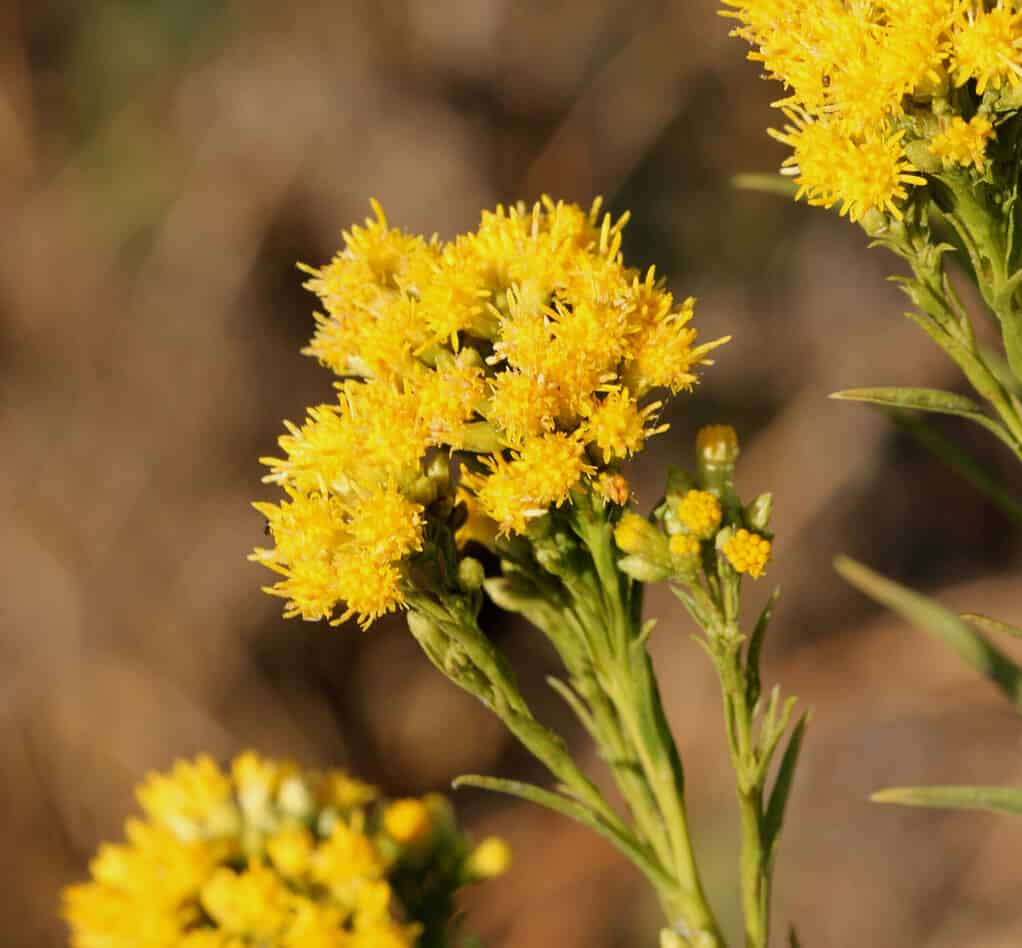
Native to North America, goldenrods have properties that make them repellent to squirrels and other pests.
©Gurcharan Singh/Shutterstock.com
Goldenrods, characterized by their bright yellow flower spikes, are native to North America and are known to attract a wide variety of beneficial insects, such as bees and butterflies, which are essential for pollination. As a plus, they can also repel certain garden pests, which, of course, include squirrels. The reason behind this repelling effect is not well-documented, but some gardeners believe that the plant’s pungent aroma and the compounds it contains may be responsible for deterring squirrels. These compounds, which are generally found in the roots and leaves of the goldenrod plant, can make the plant less palatable and tasty as well.
How to Plant Goldenrods to Repel and Keep Squirrels Out
The most important factor when using a plant to repel and keep squirrels out is, of course, the placement within the garden. Make sure to plant goldenrods near areas where squirrels have been seen in order to create a scent barrier, potentially reducing their visits. This protects your vegetable patches, bulbous plants, or other specific plants that squirrels typically target. Furthermore, since goldenrods can grow quite tall, they can also be used as a physical barrier around more susceptible plants. Their height, taste, and aroma combined may discourage squirrels from venturing beyond them.
10. Peppermint (Mentha × piperita)

You can either use the peppermint plant or the essential oil to repel squirrels from your yard.
©rawf8/Shutterstock.com
Peppermint is often known for its refreshing aroma and is a popular herb used in cooking and teas and as a natural remedy for various ailments. It is also a powerful deterrent against multiple pests. The strong scent of peppermint, which you may love, is actually a potent repellent for these fluffy critters. Peppermint plants contain menthol, which gives them their characteristic aroma. This odor can overwhelm squirrels, masking other scents that typically draw them to a garden. Squirrels rely on their acute sense of smell to locate food, so the overpowering scent of peppermint disrupts their ability to find food sources, deterring them from lingering in areas populated by this herb.
How to Plant Peppermint to Repel and Keep Squirrels Out
Consider placing peppermint near areas where squirrels frequent, such as bird feeders, vegetable patches, or flower beds. The pungent aroma of the peppermint plant will likely discourage squirrels from foraging in those areas. While peppermint’s squirrel-repellent properties can be beneficial, it’s essential to note that peppermint is an aggressive grower and can quickly spread throughout the garden. To prevent it from overtaking other plants, consider planting it in garden containers or using barriers to restrict its growth.
If you don’t have a peppermint plant or if you’d prefer not to plant this in your garden, another method is to simply soak some cotton balls with peppermint essential oil. Then simply place these cotton balls in strategic areas around your garden to repel those pesky squirrels!
Other Ways to Repel Squirrels

You can also use essential oils to mask scents in your garden to deter squirrels from entering and wreaking havoc.
©iStock.com/marrakeshh
Besides using plants as a natural method, there are a variety of different ways to deter squirrels from gardens and outdoor spaces. For example, you can create homemade sprays, formulated using natural ingredients. When diluted and sprayed around the garden, essential oils, such as peppermint, eucalyptus, or rosemary, can effectively mask the scents that attract squirrels, thereby deterring them.
Another natural remedy involves using cayenne pepper or hot pepper sprays, which, when applied to plants, makes them spicy and unpalatable for squirrels. However, keep in mind that while these methods are environmentally friendly and often effective, they may require regular reapplication, especially after rain. Furthermore, it’s worth noting that these natural methods (including planting plants that squirrels dislike) are not foolproof. You are better off using these methods as a part of a larger strategy. Consider combining various deterrent plants and natural strategies for the best results.
On the other end of the spectrum, chemical repellents are available in the market designed to repel squirrels and other pests. While these might offer longer-lasting protection and may be more effective, they can also have environmental implications, potentially harming beneficial insects or altering the soil’s chemistry. For this reason, natural repellents and deterrents are generally the preferred methods.
Summary of Plants That Repel and Keep Squirrels Out of Your Yard
| Number | Plant | Botanical Name |
|---|---|---|
| 1 | Alliums | Allium |
| 2 | Daffodils | Narcissus |
| 3 | Hyacinth | Hyacinthus |
| 4 | Common Snowdrop | Galanthus nivalis |
| 5 | Lily Of The Valley | Convallaria majalis |
| 6 | Geraniums | Pelargonium |
| 7 | Marigolds | Tagetes |
| 8 | Lavender | Lavandula |
| 9 | Goldenrods | Solidago |
| 10 | Peppermint | Mentha × piperita |
The photo featured at the top of this post is © Tom Reichner/Shutterstock.com
Thank you for reading! Have some feedback for us? Contact the AZ Animals editorial team.







